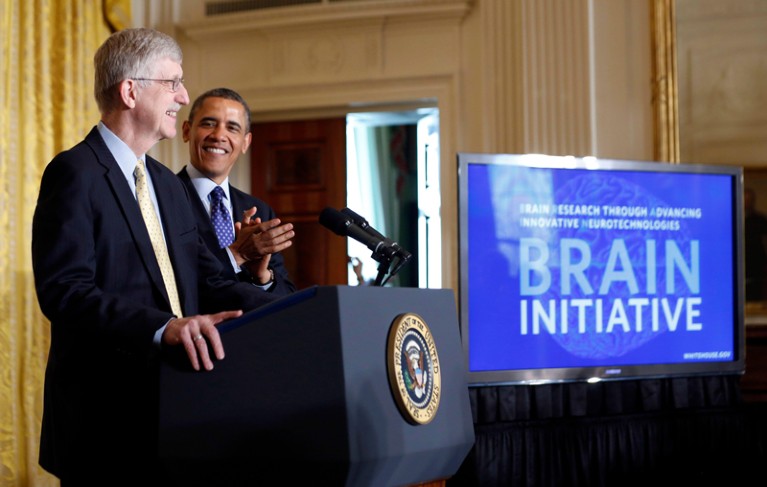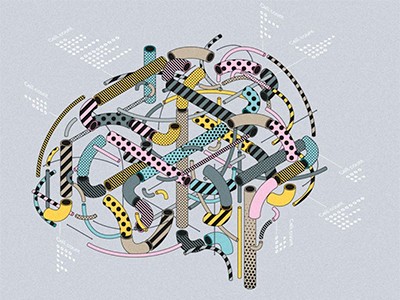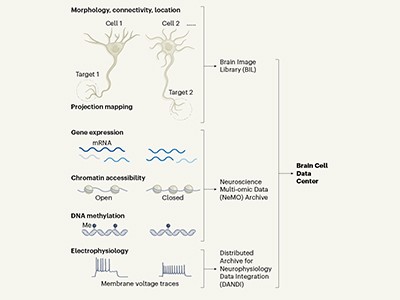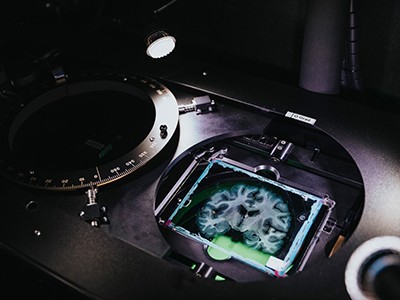
Former US president Barack Obama at the 2013 launch of the BRAIN Initiative with Francis Collins, director of the National Institutes of Health.Credit: Jason Reed/Reuters/Alamy
In 2013, then-US president Barack Obama launched a US$5-billion project to improve our understanding of the human brain. The venture would take advantage of new techniques to probe the brain’s genetics and physiology. This week, Nature reports some of the results from the Brain Research through Advancing Innovative Neurotechnologies (BRAIN) Initiative.
Although medical science continues to progress, the underlying causes of many brain disorders are not well understood at the cellular level. By the time the BRAIN Initiative ends in 2026, those involved say, it will have created a ‘gold mine’ for clinical researchers working on psychiatric, neurodegenerative and neurodevelopmental disorders.
The BRAIN Initiative Cell Census Network—Motor Cortex
The lines of evidence described in the current papers are from the BRAIN Initiative Cell Census Network (BICCN). This work is expected to help scientists to identify suitable animal models of human brain conditions — such as Parkinson’s disease, motor neuron disease and Alzheimer’s disease — that share cellular characteristics.
The BICCN project’s findings also help to explain how neurons and brain circuits are involved in emotion, behaviour and learning. These are early steps towards a more complete understanding of the neural underpinnings of human cognitive abilities — such as language and reasoning — and will keep scientists busy for decades to come.
The BRAIN Initiative is a collaboration between hundreds of researchers around the world. The BICCN project’s foundational insights include a comparison of the cells of the primary motor cortex in three species: mice, marmosets and humans1. The primary motor cortex is the part of the brain responsible for skilled movements, and the findings will help to reveal which cellular mechanisms are conserved across species. This will aid researchers in establishing the most appropriate model organism for studying neurodegenerative conditions.
A census of cell types in the brain’s motor cortex
Scientists have also created an atlas that reveals the locations of around 25 subclasses of cell in the primary motor cortex of the same three species1,2. The researchers report what neuroscientists call an input–output wiring diagram of this region in mice. This details all of the long-distance neural connections, known as axons, reaching into and out of this region; this will help neuroscientists in their investigations of how the brain exercises motor control3.
Researchers have also gained insight into how cells in the human neocortex — the thin outer layers of the two cerebral hemispheres — acquire their identities during embryonic development4. And the project is providing scientists with tools with which to visualize and mine vast new data sets. In addition, researchers have started to create a genetic ‘toolbox’ that exploits characteristic differences in gene expression in particular cell types to label and manipulate those cells5. In just a few years, scientists expect to be able to peruse an online atlas charting the type and location of every cell in the mouse brain. All of the data will be freely available.
However, it’s a big leap from creating what the researchers call a cell census to understanding the precise information that a particular network of neurons is processing. Scientists do not yet know how the brain processes the streams of sensory information that tell us that we’re hungry or cold, or that create a lifetime of memories.
How the world’s biggest brain maps could transform neuroscience
Some neuroscientists think they will be able to crack the basis of these computations by breaking them down into their individual physiological and behavioural components. Others are pinning their hopes on a universal theory of brain function. One such theory, called active inference, visualizes the brain using predictive models to regulate physiology and behaviour6. It relies on a processing hierarchy with predictions flowing in one direction and prediction errors reported back in the opposite direction.
The BICCN researchers provide some of the tools needed to test the theory, including those required to identify and manipulate the cells that might be involved in such a circuit. But one of the experimental challenges will be to combine these cell-level tools with models of a particular aspect of perception, cognition or behaviour in live animals. Another challenge is determining the extent to which animal models might reveal useful insights about the human brain.
The BRAIN Initiative has already revealed a high degree of evolutionary conservation between the basic cellular components of the brain in different mammals. This is not surprising, given the extensive genetic overlap and similarities between species in behaviours such as eating and reproduction. But it is also reassuring, given the challenges we are already aware of regarding the extent to which animal models provide useful insights about the human brain. Whereas the mouse brain hosts around 70 million neurons, the human brain boasts some 86 billion, each one bristling with synapses, which allow them to connect to other cells. Many neurons have thousands of synaptic connections.
This difference in scale is among the reasons that Hongkui Zeng, an author of a number of the papers in this collection and director of the Allen Institute for Brain Science in Seattle, Washington, says it will take at least 50 years to create even a crude wiring diagram of a typical human brain. But as the papers published today show, scientists are making important inroads in deciphering the brain and creating tools that will one day unlock the secrets of our uniquely human cognitive attributes.

 The BRAIN Initiative Cell Census Network—Motor Cortex
The BRAIN Initiative Cell Census Network—Motor Cortex
 How the world’s biggest brain maps could transform neuroscience
How the world’s biggest brain maps could transform neuroscience
 A census of cell types in the brain’s motor cortex
A census of cell types in the brain’s motor cortex
 Read the paper: A multimodal cell census and atlas of the mammalian primary motor cortex
Read the paper: A multimodal cell census and atlas of the mammalian primary motor cortex







